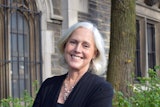With great fanfare and high hopes, celebrities Oprah Winfrey, Muhammad Ali and Laura Bush helped break ground for the National Underground Railroad Freedom Center in downtown Cincinnati in June 2002.
Two years later, the $110 million center, 10 years in planning, opened with exhibits on how enslaved African-Americans risked their lives to make the northward trek to freedom. Yet, the project suffered declining attendance and budget cuts. Within the last three years, the center has eliminated about 30 percent of its staff.
Today, however, a comeback is imminent. The center is shifting its focus while serving as an educational focal point, research asset and change agent. Area universities use it to research human rights, advance digital technology as a teaching tool and help train future educators.
In a new twist, the center has become a starting point for research and advocacy involving 21st-century slavery and human trafficking.
“We try to convey that slavery didn’t end with the Civil War,” says center spokesman Paul Bernish.
Modern-day slavery can involve such events as young girls being kidnapped and forced into prostitution in India or Thailand, known for its sex tourism. Other forms involve forced labor.
“About 12 million people around the world are involved (in modern-day slavery), and about 43 percent involves the sex industry,” says Bernish.
In Ohio, South Korean women are forced into prostitution, according to center research. They work from recreational vehicles that pass from Canada to various places in the U.S., including Cincinnati. Other forms of modern-day slavery involve undocumented immigrants, largely Latino, whose livelihood and lives are in the complete control of their factory foremen.
Although 40 states have laws against human trafficking, as does the federal government, the situation needs more attention. Bernish says the center helps lobby state legislatures such as Ohio’s to toughen laws and raise awareness. Last July, the center published a report on modern-day slavery and has held exhibits in Cincinnati and elsewhere.
The topic is a rich vein for area schools to mine. Modern-day slavery is a major study area for the Urban Morgan Institute for Human Rights at the University of Cincinnati. Students from the university’s law school have put together two displays at the Freedom Center on the issue.
Empathy and soul searching are a big part of the center experience. The lynching exhibit is so graphic that parental discretion is advised before schoolchildren view it.
In fact, the center has a Dialogue Room, where viewers can go to reflect on the museum material, says Dr. Cathy McDaniels Wilson, a clinical psychologist who teaches at Xavier University. She worked at the center until budget cutbacks ended her position in 2009.
The center also focuses on just how large the influence of African-Americans has been not just in the U.S. but globally.
At times, that experience can hit home. Dr. Charles Walker Gollar, an associate professor of church history at Xavier, says his students study the role of the church among slaves and the churches’ relationship with the Underground Railroad. As part of his research for his doctorate, Gollar learned his ancestors were slaveholders in the 1780s and early 19th century in Bardstown, Ky.
Although Gollar says he did not make the discovery through the center, the institution does have a genealogical division that can help visitors trace their personal connections to slaves or slave owners. The bulk of the museum is designed for K-12 students. As such, it can be a laboratory for education majors planning teaching careers. One related endeavor involves education students at the University of Cincinnati who will take a new, three-credit course in late March called Digital Media and Inquiry. According to Dr. Janet Mannheimer Zydney, assistant professor of teacher education, the course will be completely online as a way to teach new educators about how to use the Web as a teaching tool.
“Content is about the Underground Railroad, and the center is the jumping-off point,” she says.
All discussions will be interactive. The center fits into the course because it makes vigorous use of iPods and digital backpacks as teaching tools for visitors. Although many educators who use the center acknowledge its value, some are critical. Gollar says his research into slavery sometimes stands at odds with what the center presents. He says fewer slaves used the Underground Railroad than the museum seems to contend. Many went no farther than Cincinnati and other border towns because they wanted to try to be close to families even though free visits were impossible.
“The vast majority of slaves did not run away. Obviously they were not happy, but they chose the value of the family over the institution,” he says.
The center still faces considerable obstacles. In 2007, the last year finances were publicly available, the center operated at a loss of $3.4 million. “The fundraising environment,” Bernish says, “is very tough these days.”
















